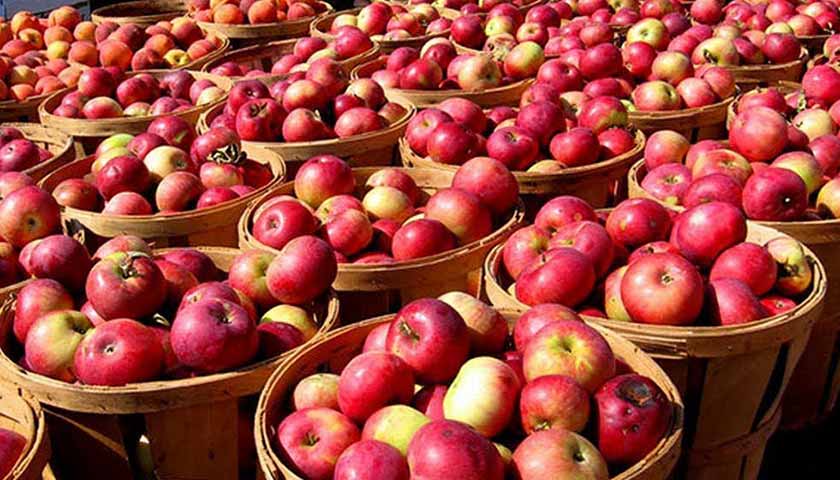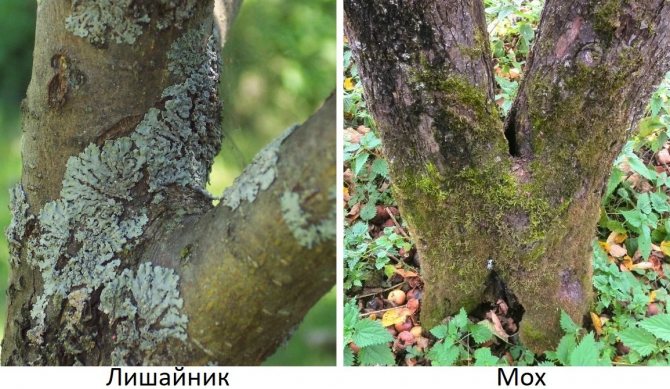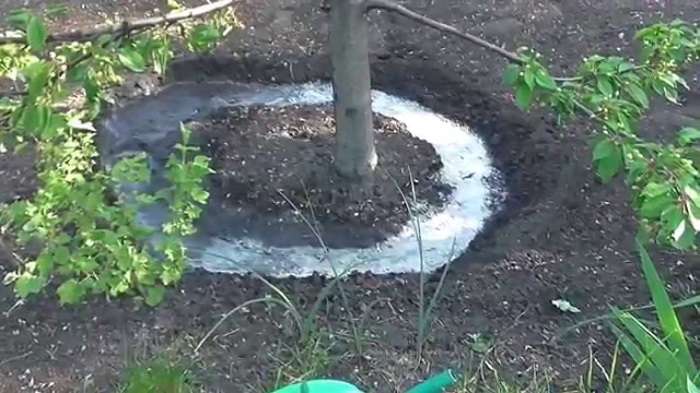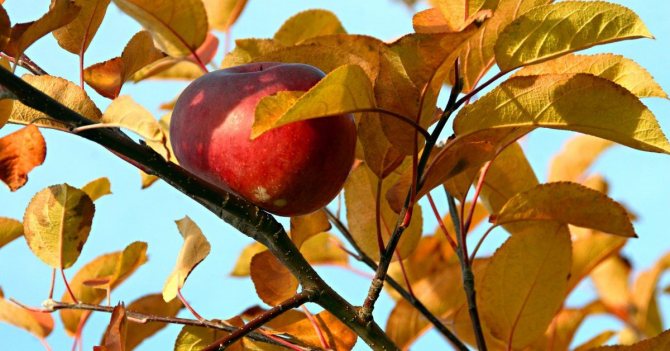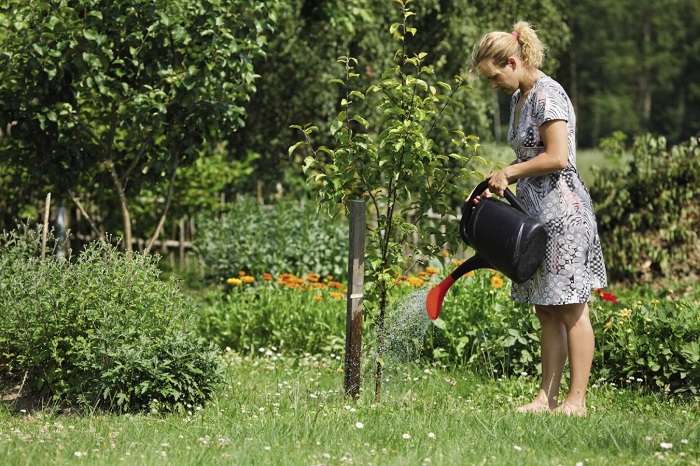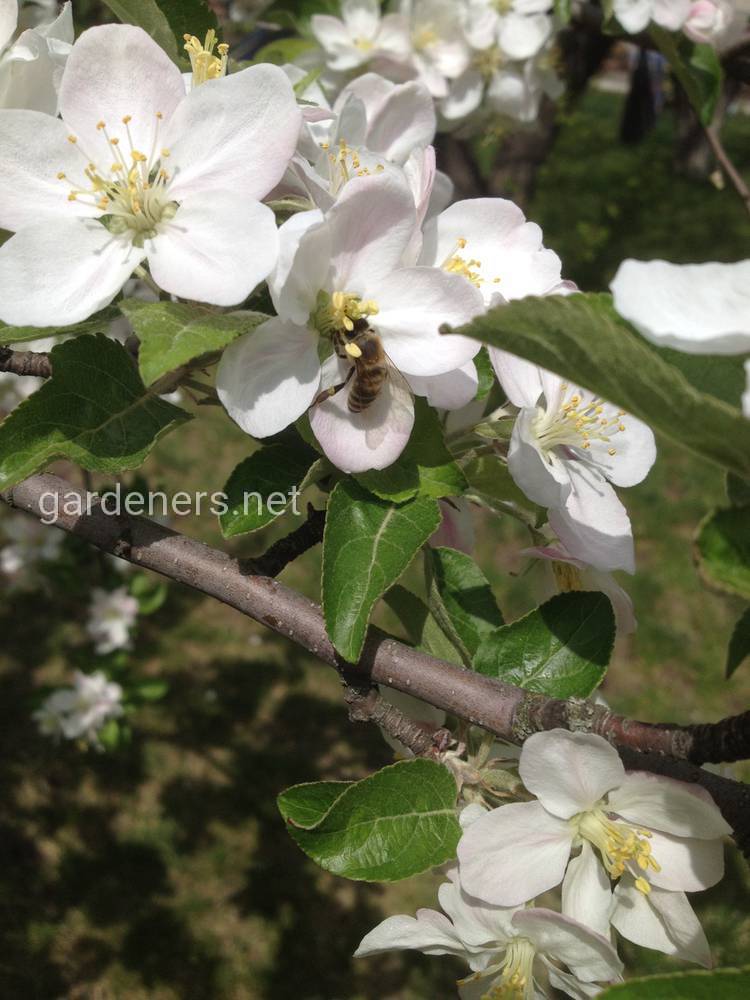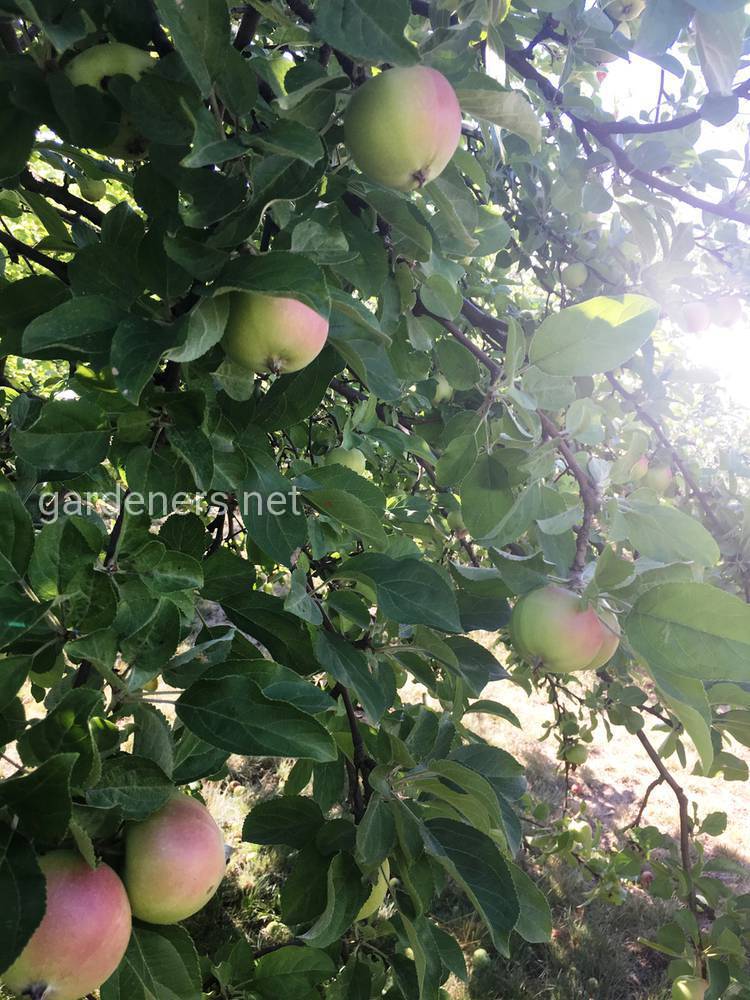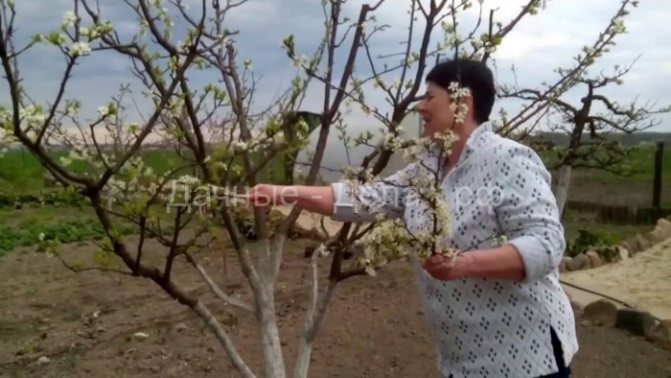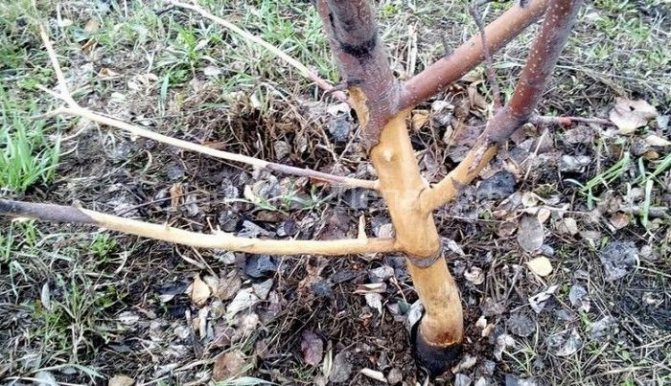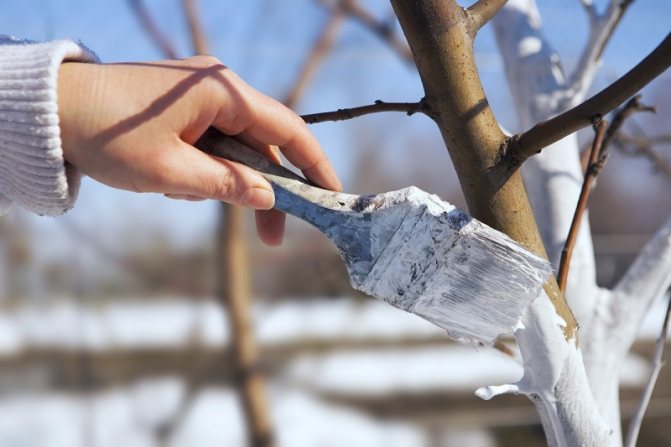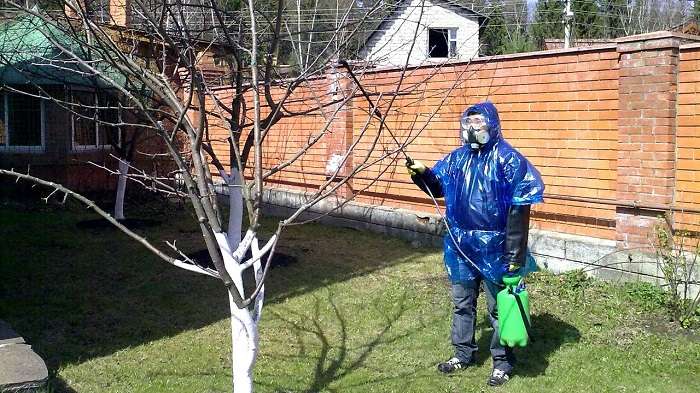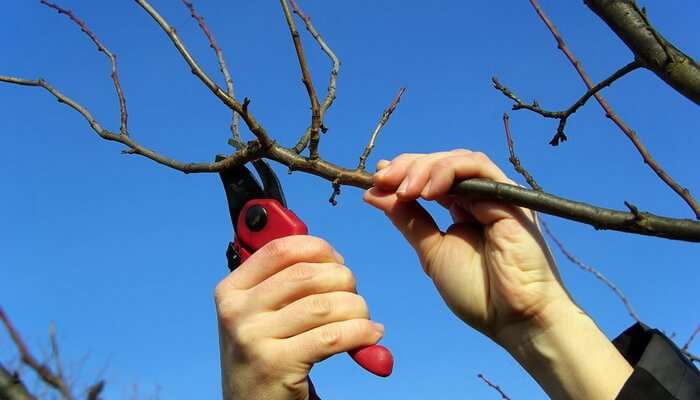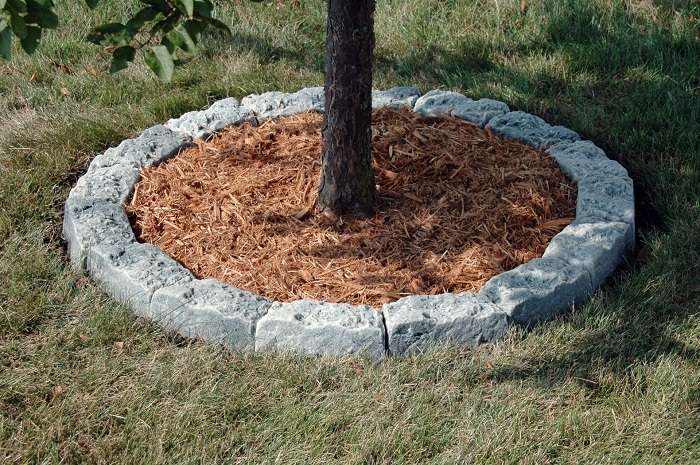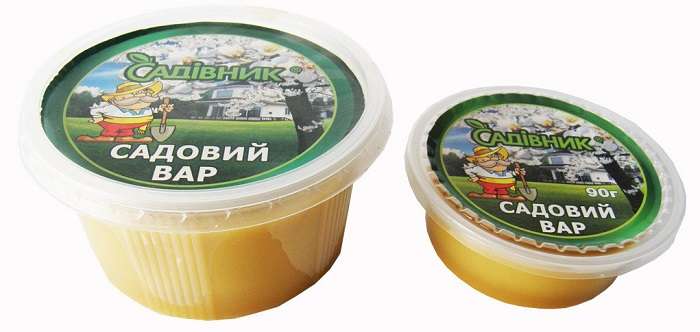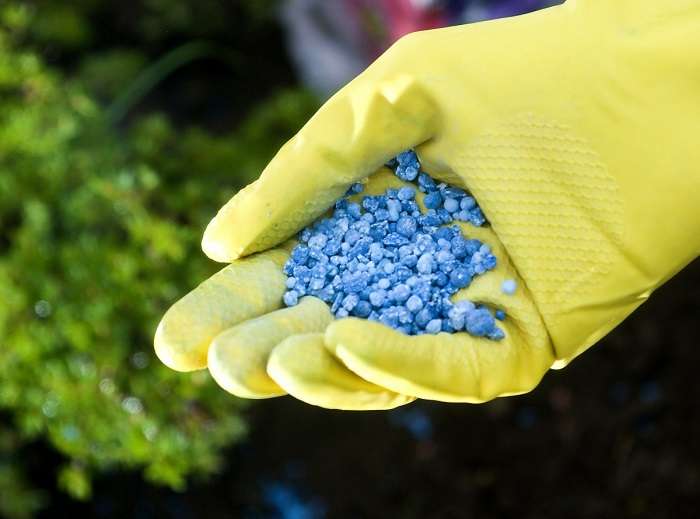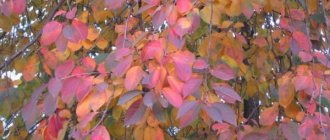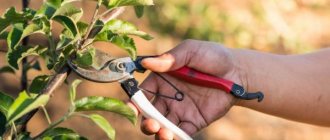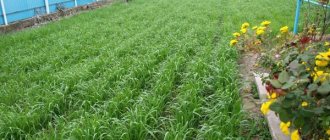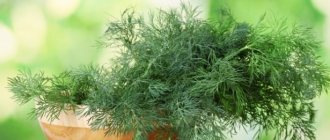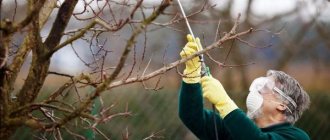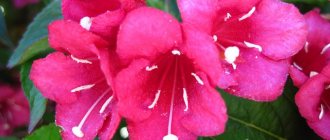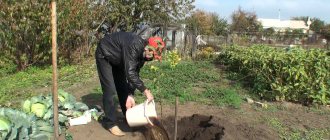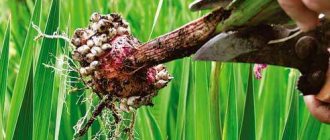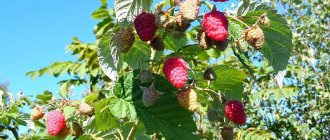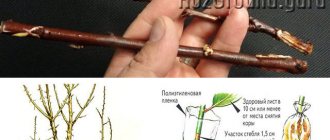Preparing apple trees for winter is a responsible matter, on which not only the harvest of the next year depends, but also the vitality of the trees themselves. It is especially important to know how to prepare apple trees for winter in Siberia.
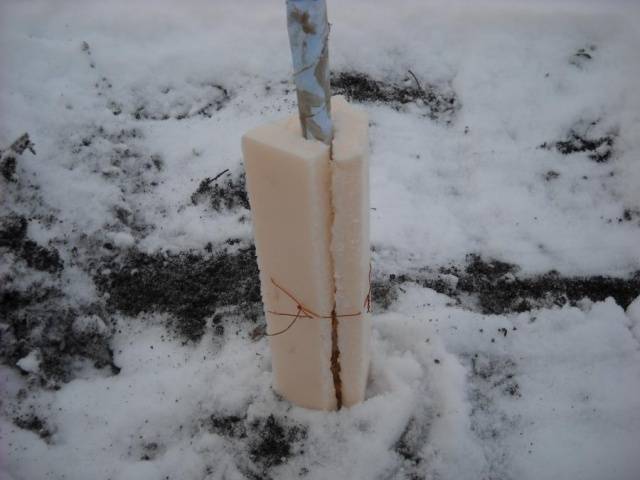
The climatic features of Siberia are characterized by severe frosts - the temperature drops to -40 degrees even on calm days. If the apple trees are not well covered by winter, there is a great danger of their death.
Planting seedlings
To move on to the question of how to care for an apple tree, you first need to know how to plant it correctly. It is necessary to perform this procedure in early spring - immediately after the snow melts.
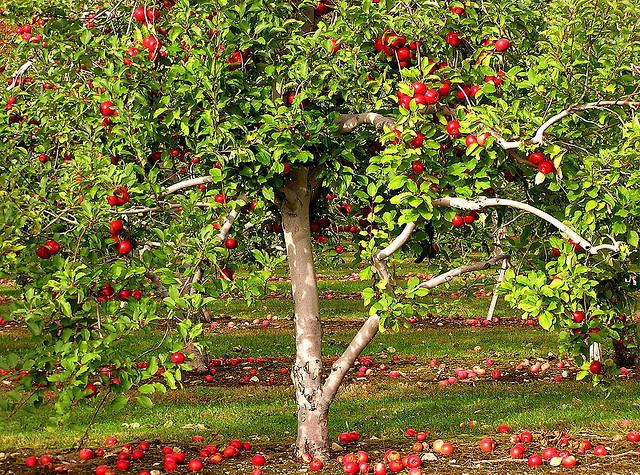

Make sure that the top layer of the soil is not frozen, otherwise the planting can be delayed. Usually the best time to plant apple seedlings is April or early May.
So, let's move on to the planting process itself. First of all, we mark with pegs the places in which we will do this. It is advisable to leave at least four meters of free distance between the plants, so that each of them can fully develop. If the apple variety you are planting has a wide crown, then this distance should be equal to five meters.
After marking, you need to dig a hole for each seedling. Its depth should be 0.6 m, width and length - 0.6-0.7 m. The clay or sandy part of the soil must be folded in one direction, and the humus part - separately, in the other. If the soil in your area is infertile, then you need to enrich it with substances useful for plants, pouring two buckets of humus into each hole, a pound of phosphate fertilizers and about 60 grams of potash fertilizers. All these substances must be pre-mixed with the top layer of the excavated earth. Then we take out the seedlings from the storage area and inspect them for dried or damaged roots. If any were found, delete them. Having covered the fertilized soil at the bottom of the hole, we make a layer of ordinary soil, not saturated with fertilizers, on top. This is necessary so that the roots of the plant do not come into direct contact with the fertilizer, as this can be harmful to them. Next, you need to install the seedling over the ground in the hole so that the root collar is exactly at the level of the ground surface. If it is much lower, the plants will grow much slower and worse, but if it is higher than necessary, the roots will begin to dry out. Then we fill in the rest of the earth and compact it for better fixation of the plant.
Apple tree care
Apple tree care procedures depend on the current season. It should be noted right away that most of the manipulations with the plant are carried out in the off-season. In the summer season, when the buds open and the fruit appears, all that is required from the gardener is to pick apples in a timely manner and to monitor the absence of pests. During winter, the best thing to do is to leave the tree alone until the first sign of warming.
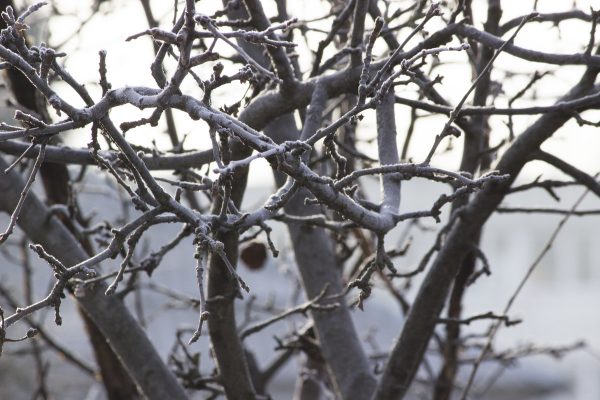

Least of all, the apple tree needs care in the winter, being in a state of rest
The main work begins either at the end of the growing season, or even before it begins, respectively, in the spring and autumn months.It is at this time that the branches of the apple tree become bare, which allows the gardener to diagnose their condition and make the correct pruning, which will help the plant survive the winter and improve its qualities by summer. In addition, autumn-spring pruning is safe due to the fact that the movement of juices is stopped, which means that the wounds of the plant heal faster.
Autumn season
The main goal of autumn care is to prepare the tree for wintering, which is stressful for each plant. With proper processing of the apple tree, you can achieve not only a comfortable transfer of winter by the tree, but also an increase in its yield.
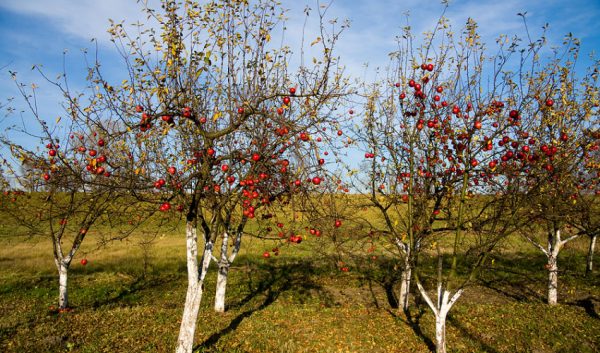

Preparing an apple tree for wintering is the main task of autumn care.
Pruning
All gardeners are familiar with the pruning procedure, one way or another. In the autumn, care should be taken to remove:
- Dying, damaged and non-viable branches that take nutrients from the plant;
- Infected branches that can infect the entire tree. After removing such branches, it is advisable to burn them in order to avoid the spread of the pathogen into the soil or to neighboring plants;


The more useless shoots you remove in the fall, the easier the apple tree will survive the cold.
Important! After cutting off the rejected branches, it is necessary to treat the wounds of the tree with a solution of copper sulphate and cover it with garden varnish in order to avoid the growth of the fungus on a damp surface that is vulnerable to infections and pathogenic bacteria.


Autumn pruning of a dwarf apple tree in the third year of life
Pruning should be done on a dry, warm day. The slightest precipitation will wash away the applied compositions, meaningless all the procedures carried out to protect the plant. It is also not recommended to remove branches at temperatures below ten degrees, since a weakened tree runs the risk of cracking.
Moss removal
Despite the fact that small amounts of moss and lichen do not harm the life of the tree, it is recommended to get rid of these parasitic plants as they spread. The more area they occupy, the more difficult it will be for the apple tree to "breathe", since the moss will block the tree's access to air, which threatens to gradually dry out the branches.
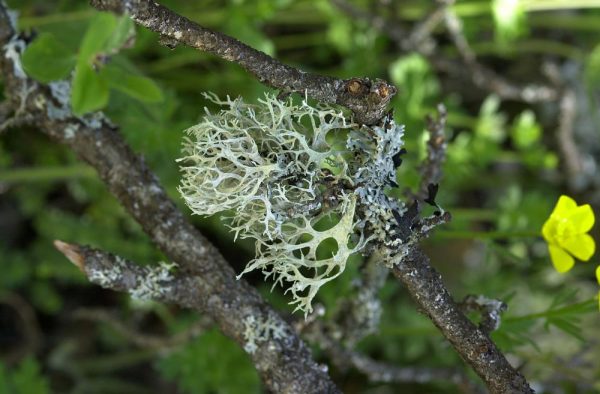

It is undesirable to wait for the growth of lichen colonies on all surfaces of the apple tree bark
If the habitat of mosses or lichens is still small enough, you can remove them manually with a plastic scraper. After cleaning out unwanted plants, it is necessary to treat the damaged areas of the tree first with copper sulfate, and then with varnish - in the same way as it is done with sanitary pruning of branches.
Whitewashing the trunk
Autumn whitewashing is an optional procedure, but it helps to protect the apple tree from rodent attacks and the rays of the winter sun, which adversely affect the tree. A section of the trunk, starting at the very base and ending with skeletal branches, needs whitewashing (if you wish, you can climb higher).
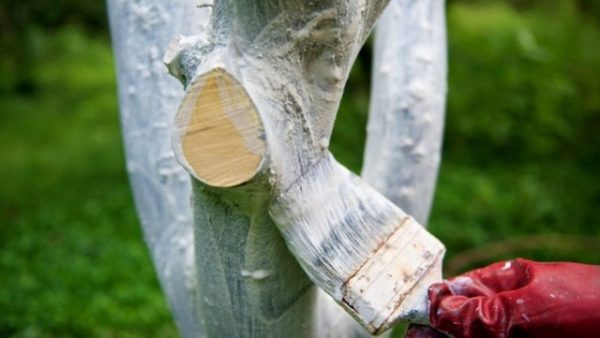

Whitewashing prevents parasites from breeding under the bark of the apple tree and protects the tree from the best direct sun
As a material, you can use both a ready-made mixture, which can be bought at any store for gardeners, and a handmade mixture. The recipe for the homemade mixture is quite simple. You will need:
- Half a kilo of copper sulfate;
- Three kilograms of lime;
- Two hundred grams of wood glue.
More details about the tricks of whitewashing and the appropriate time for the procedure are described below.
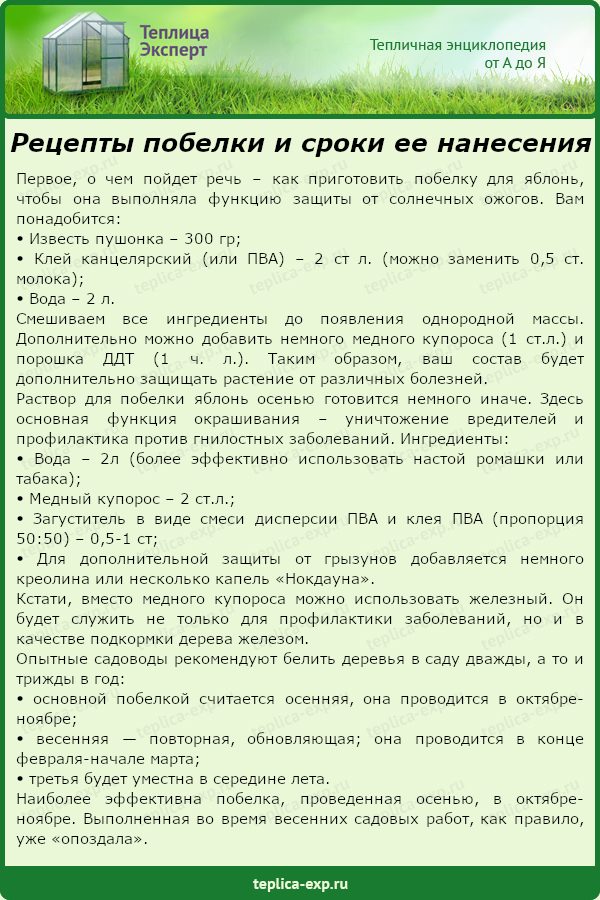

Whitewashing recipes and timing of its application
By the way! In addition to protection from insects, apple trees also need protection from hares and mice, which cause no less damage to the tree. In order to protect the plants, it is necessary to tie it with pine branches or several layers of cardboard.
Whitewash mix prices
whitewash mixture
Tillage
After you have pruned and whitewashed the apple tree, it's time to start cultivating the soil. Autumn soil care includes several stages:
- Cleaning and cleansing. Since autumn is the time of leaf fall, it is necessary to remove all fallen leaves from the site in a timely manner. Despite the beauty of autumn red-yellow leaves, pests are very fond of planting in them, getting rid of which takes a lot of effort, time and patience. After cleansing the soil from rotten fruits and foliage, it should be treated with lime. From all discarded plant residues, you can collect a plant heap, which will subsequently serve as an excellent fertilizer;
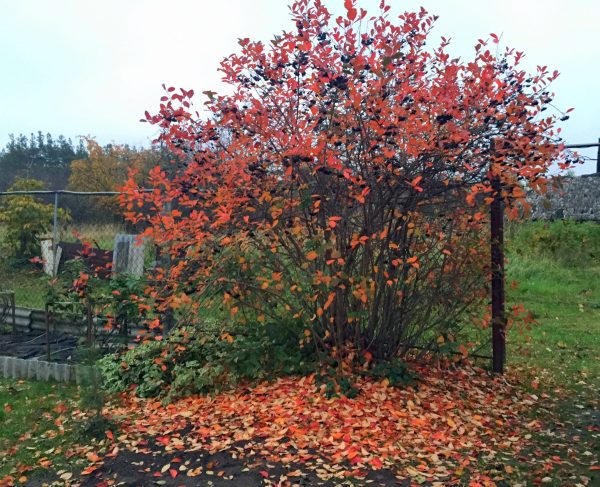

In autumn, a lot of fallen leaves remain in the garden, which attract insects.


By loosening the soil, you prevent the reproduction of pests in its depths
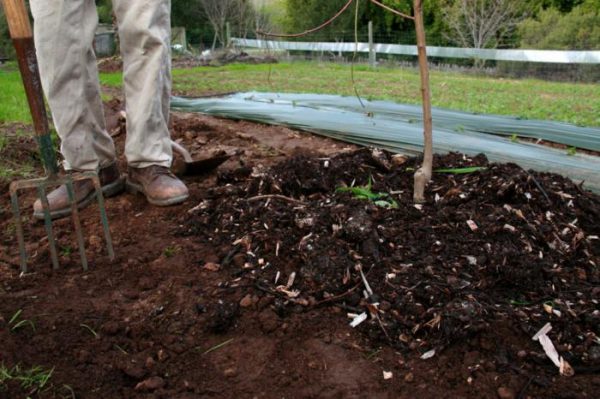

Mulching will trap moisture inside the soil and inhibit weed growth
Top dressing
Top dressing is traditionally the final stage in the autumn care of the apple tree. The need for this procedure is questioned by some gardeners, therefore the decision to carry out feeding is made individually. It is believed that top dressing helps the tree get through the winter season.


In the fall, you should pay attention to fertilizers with a high potassium content.
To carry out feeding, it is necessary to process one square meter with the following materials:
- Five or six kilograms of humus or compost;
- One hundred grams of superphosphate;
- One hundred grams of potash fertilizers.
Please note that the younger the apple tree, the more carefully you should approach its feeding. The fact is that some fresh undecomposed organic fertilizers tend to burn the roots of a young plant. That is why, when fertilizing the soil around the apple tree, only rotted manure is used.
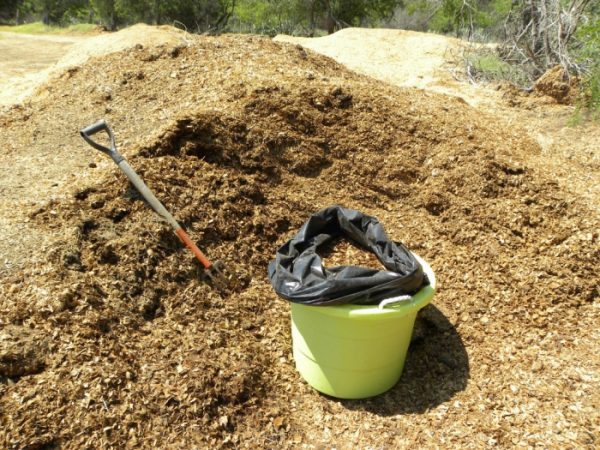

Fresh manure can burn the roots of the apple tree, and therefore is not suitable as a top dressing
Important! When calculating the amount of fertilizer per square meter, the type of apple tree should be taken into account. Above are the proportions suitable for feeding tall apple trees. Dwarf apple trees will be quite enough 75% of the total specified mass.
Spring season
Caring for an apple tree in the spring season in many ways repeats the procedures typical for the autumn season, with the exception of some details, which we will dwell on in the following chapters.
Winter injury treatment
In winter, the tree is susceptible to cracking due to a decrease in temperature, and to attacks by rodents interested in the bark of the apple tree. To heal the wounds left by the sharp teeth of animals, it is necessary to treat them with garden varnish. In this case, you need to ensure that the composition does not fall on the healthy bark, since it releases substances that contribute to the speedy recovery of the plant.
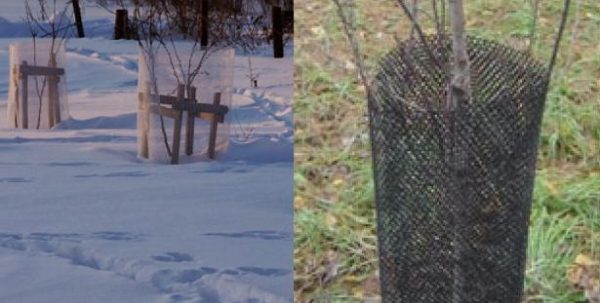

To prevent rodent attacks, you can pre-wrap apple trees with a net.
Also, in early spring, you are likely to encounter cracks that have formed as a result of prolonged frost.To prevent their spread, it is necessary to process the cracked areas up to healthy wood with the same garden varnish. The dead edges of the detached bark should be removed.
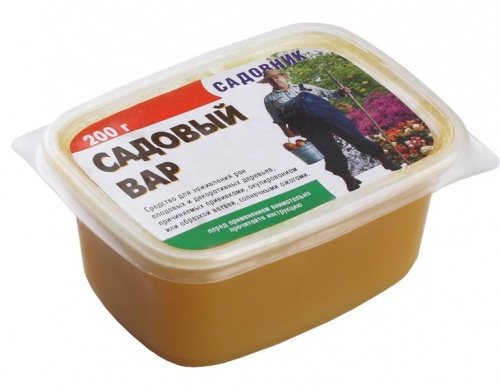

Garden var is a versatile remedy in the fight against any damage to the bark.
If the damage is too great and one garden pitch is not enough, you should use the bridge grafting to save the life of the apple tree. Such grafting will help to restore the circulation of sap in the injured areas and prevent the tree from drying out.
Pruning
When starting the spring pruning of a tree, the gardener should remember that he should complete all procedures before the beginning of the growing season. The main goals of spring pruning are:
- Crown formation in young apple trees. The crown of the tree should be well ventilated and receive sufficient sunlight. In this regard, all tangled side branches growing deeper into the crown should be removed;
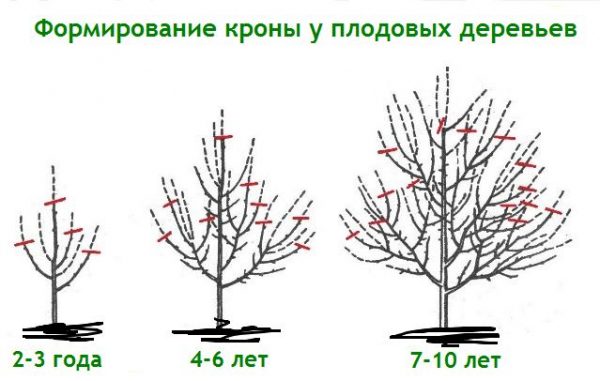

The formed crown is the result of many years of painstaking work
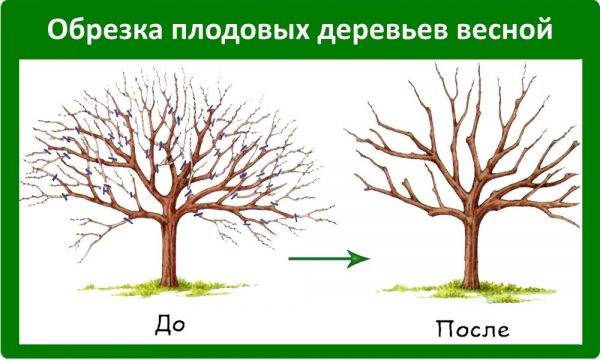

Reducing the number of side branches allows the apple tree to improve its yield


Scheme of pruning an old apple tree
Graft
Vaccination refers to specific spring manipulations that are not carried out in other seasons. The main purpose of grafting is to increase the yield of an apple tree by grafting a cuttings from another tree into it. As a rule, gardeners start grafting in May, since in order for it to be effective, active circulation of juices in the apple tree is necessary.
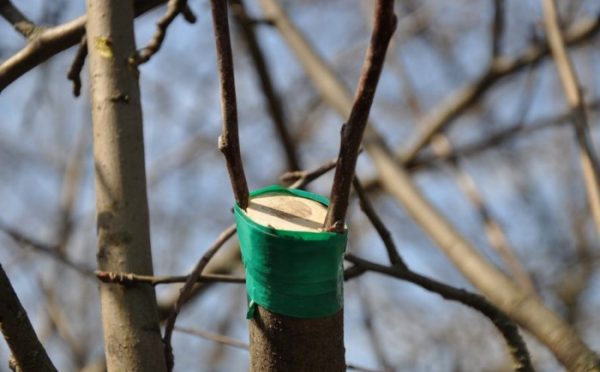

Correctly performed grafting not only increases yields, but in some cases saves the life of the tree.
There are two types of grafts, depending on the diameter of the branches to which the cuttings will be attached:
- Split: branches of almost all sizes are suitable for this method;
- Bark grafting: requires large diameter branches.


Scheme of grafting an apple tree for bark
Video - Grafting fruit trees
What to do next?
Care for young apple trees just planted in the ground must be especially careful. It is on how the owner watches the plants in a given period that their further development depends. If in the early years caring for an apple tree in spring, summer and autumn is negligent, then it will simply dry out, without even beginning to bear fruit.
Caring for an old apple tree is not that difficult. The first thing to do is be sure to water. For him, you need to prepare special rims according to the diameter of the holes in which the plants were planted. They should be about 0.15 m wide.
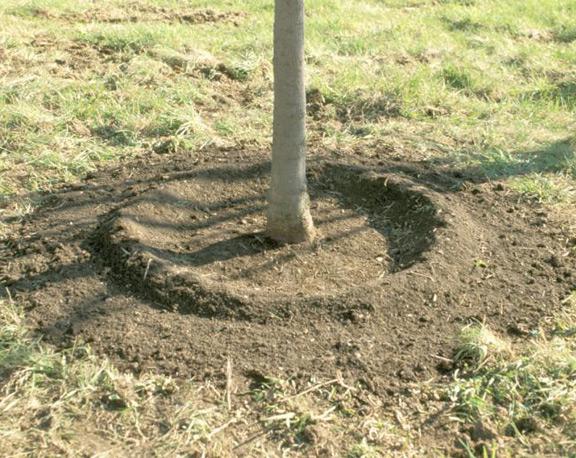

This is necessary so that moisture gets exactly as intended, that is, to the roots of the plant, and does not spread over the rest of the area of the site. For each young apple tree, one watering should take two or three buckets of water.After it is absorbed into the soil, it is advisable to sprinkle the hole in which the tree was planted with dry soil or humus. This is necessary so that the moisture does not evaporate longer. It is best to water the plants once every two to three weeks, but with frequent precipitation, this can be done less often.
Warming of seedlings for the winter
Saplings are insulated in the same way as adult trees, but the main thing is to do it on time. Otherwise, in winter, the bark will crack from frost, and the roots will rot, the seedling will die. Therefore, special attention should be paid to the roots:
- manure is spread around them in a circle;
- a dense layer of sawdust is laid on top of it;
- the root collar is carefully wrapped with insulation - agrofibre has excellent qualities;
- for barrel insulation, white wrapping paper is used - the white color reflects ultraviolet rays and protects the barrel from sunburn.
Important! When insulating an apple tree for the winter, it is not recommended to use roofing material or film - they can cause the formation of fungi in the event of a thaw.


It is imperative to tie the seedlings to the pegs, as there are often strong winds in Siberia. Experienced gardeners surround the seedling with a small hedge of pegs to keep out the gusts of wind. After covering the trunk of the seedling, the root collar is insulated with manure, and an earthen mound up to 30 cm high is poured on top. Rotting, the manure will provide the roots with minerals, creating favorable conditions for the further development of the tree. A thick layer of snow is sprinkled on top of the earthen mound. Such a shelter will allow a young seedling to endure severe frosts and grow quickly in spring.


One of the main stages of care
This is an apple tree pruning. It is necessary for all plants, but especially for young ones. Apple pruning is carried out immediately after planting it in the ground. If the conditions for the plant to take root are very favorable, which includes a sufficiently developed root system, a high level of soil moisture, early planting, etc., then pruning is done by only a third of the trunk. If the shoot has already branched out, then each branch should be shortened. If the conditions are not very favorable, for example, too hot and dry weather, late planting in the ground, then the pruning must be done thoroughly - up to half of the entire shoot.
An adult apple tree also needs to be pruned - this is necessary for better growth and the formation of a beautiful crown. In this case, first of all, it is necessary to get rid of the hanging parts of the lower branches. Then the uppermost branches should be shortened, with the exception of those that are directed to the sides. Thus, we reduce the height of the tree and form a more lush and free crown, which is necessary so that all branches receive a sufficient amount of light.
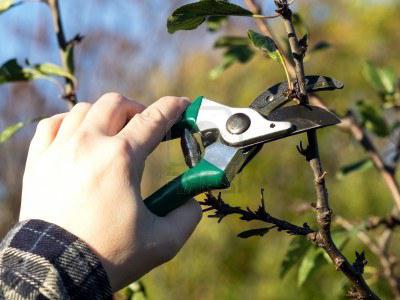

When to start preparing for winter by region
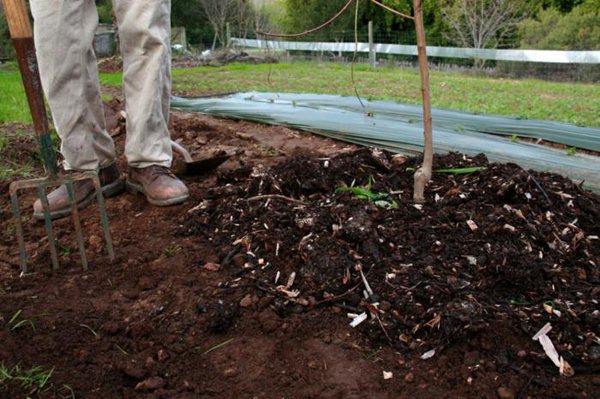

In the cold season, apple trees are susceptible to the negative effects of subzero temperatures and the invasion of rodents and hares. To protect trees from cold and pests, they need preparation. It is necessary to start work on preparing apple trees for winter with the onset of autumn. In each region, these periods differ and depend on the climatic features of the area and the weather in general.
It is very important to choose the right moment when it's time to hide the apple tree. When activities are carried out ahead of time, when the subzero temperature has not been established and there is a possibility of the return of warm days, there is a possibility that the roots of the tree will decay and the growth of young shoots will resume. This almost always leads to the death of the apple tree in winter. To prevent this from happening, you need to follow the deadlines and additionally focus on the weather in the current year.
In outskirts of Moscow
In the Moscow region, the preparation of apple trees for winter begins in mid-October. By this time, there will be no leaves on the trees, and they will enter a dormant period.Shelter for the winter is carried out at a stable air temperature equal to - 8-10 degrees of cold.
In the Urals
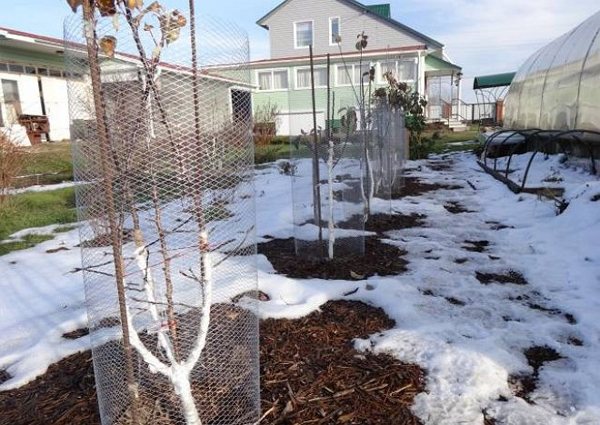

In the Urals, the preparation of apple trees begins in September. By this time, there should be no fruits left on the trees; if they remain, they must be cut off. Preparatory work is coming to an end when the weather is cold.
In Siberia
Work on the preparation of apple trees for winter in Siberia begins with the arrival of autumn. Brown leaves on the apple tree indicate that the tree is ready for winter.
In the Leningrad region
In the Leningrad Region, preparation for the winter of apple trees begins in mid-September or after the first frost. In wet weather, they can be put off for a few days.
When and how best to fertilize?
Continuing the conversation about how to care for an apple tree, let's move on to a very important topic - about fertilizers. They are of two types - mineral and organic. The former are also subdivided into two main subtypes - potassium and phosphate. Caring for an apple tree involves the use of both types of fertilizers. If you, following the instructions, enriched the soil with useful substances during planting, then for the next few years you will no longer need to do this. However, if for some reason you did not fulfill this condition, then fertilization can be applied already in the first year of plant development. Enriching the soil with minerals and other useful chemical compounds is one of the stages that includes caring for an apple tree in the fall, since it is best to do this at this time of the year. One square meter of soil will need the following ingredients:
- 0.02 kg of ammonium nitrate;
- the same amount of potassium salt;
- 2-3 kg of humus;
- 0.05-0.06 kg of phosphate fertilizers.
Fertilizers should be embedded in the soil to a depth of about 0.01 m around the trunk and about 0.02 m in those places where the root system of the apple tree does not lie. This procedure is not carried out every year, but every two or three.
Autumn feeding of apple trees
After harvesting, the apple tree is significantly depleted and lacks nutrients, therefore it needs mandatory feeding.
In autumn, it is recommended to apply fertilizers containing potassium and phosphorus to the soil around the trunk - they strengthen the tree's immunity, and also stimulate an increase in yield. In this case, you can use store complex fertilizers or prepare them yourself.
Video: autumn feeding of apple trees
Autumn feeding of the apple tree should be carried out according to the following rules:
- It is best to apply fertilizers in liquid form along with watering - this way they are absorbed faster by the roots of the tree.
- Top dressing is carried out in early September or after the leaves have completely fallen off, but no later than 3-4 weeks before the first frost.
- For watering 1 m² of area, you need to dissolve 2 tbsp. l. phosphoric and 1 tbsp. l. potash fertilizer in 10 liters of water.
- In autumn, apple trees cannot be fed with nitrogen fertilizers - this will cause active growth of shoots and their freezing when frost sets in.
- To increase the frost resistance of the tree, it is watered with a superphosphate solution (30 g of substance per 1 liter of liquid).
- Instead of potassium-phosphorus fertilizers, you can add humus or compost in the amount of 4–8 kg per 1 m².
Watering adult apple trees
We have already considered how to carry out this procedure in the case of seedlings, now we will talk about trees that are more than two years old. Watering is the main component. Such care for the apple tree is especially important in summer, since it is this season of the year that is the driest and hottest, which is not particularly favorable for plants (and not only for apple trees).
A tree two to three years old should be watered frequently, but in small portions. The first time this is done, as a rule, in early June. Water should be consumed, focusing on the number 4 buckets per 1 square meter of soil. The area to be moistened is calculated by looking at the crown, that is, all the ground under it must be watered. The procedure should be repeated every fifteen to twenty days.For more effective moistening of the root system of the plant, it is advisable to loosen the soil around the trunk before watering.
An apple tree that is more than three years old should not be watered so often, as this can lead to a reduction in yield. It is enough to water it once a month, but in large portions. In this case, you need to spend about 40-42 buckets of water per tree.
Harvesting apples
In early autumn, depending on the variety and planting time, most apples ripen. It is advisable to carefully pick the fruits by hand, wearing gloves for this. In order to increase the shelf life of apples as much as possible, you need to make sure that the skin is free of plaque and intact. After harvesting, it is necessary to process the crown of the apple tree with urea to protect it from scab.
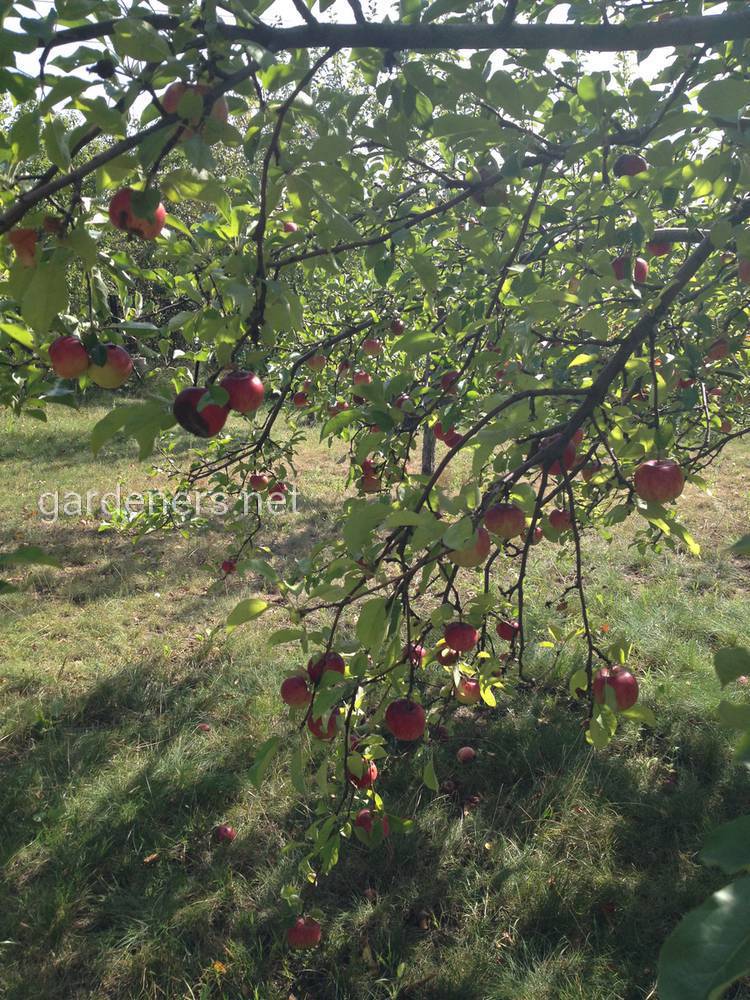

Join our group
Tinning
This is a special type of care that is typical for columnar apple trees. It consists in sowing cereals or all sorts of spices around the trees (lemon balm, dill, which, by the way, can also protect from pests), and then periodically carefully mow them. Such a procedure is necessary for plants because their root system is very close to the surface. It is not pivotal, that is, it does not have a main root extending deep into the soil. Because of this, the roots can easily suffer from external influences on the soil above them. And due to tinning, this possibility is much reduced. In addition, mulching can be used for the same purpose.
Why do you need to cover apple trees
Many novice gardeners believe that apple trees need to be covered solely for protection from frost. But it is not so. Of course, young apple trees can freeze in severe frosts, but not only this threatens them. The main reason why such a shelter is needed is protection from rodents, which very often feast on the juicy bark of seedlings.
Insulating the trunk will help protect the bark from the piercing wind, which can dry it out. The spring sun can also harm apple bark, it can cause burns. The quality of the harvest and the fruitful period depend on how competently the shelter measures for the apple tree will be carried out for the winter. A young apple tree, deprived of shelter, may die, its skeletal branches will freeze, and the root system may freeze out. This is especially true for apple trees grown in Siberia.
If the bark of an apple tree is damaged, it will not be able to develop normally and grow in spring. There won't be a good harvest either. The bark, which has lost its integrity, is susceptible to diseases, which can lead to the death of the tree. Protecting the bark by covering it for the winter is an important task for the gardener who takes care of his garden.
Read also: Honeysuckle Nymph: description, photos, reviews, pollinators, planting and care
Pruning a columnar apple tree
It has its own characteristics and differences from a similar procedure in the case of ordinary varieties. Trimming is carried out only on lateral branches, which are already available in very small quantities. It is impossible to violate the main trunk, as this can lead to the regrowth of a larger number of lateral branches - and the columnar apple tree will no longer look like that. This operation should be carried out as follows. The side branch is cut so that three to four buds remain. In this case, she will give about three shoots. But in the first year, it is only cut for two buds. Then, in the second year of the plant's life, that lateral shoot that is farther from the trunk must also be shortened by two buds. The first one, which you did not touch, will already begin to bear fruit this year. The next spring it needs to be removed completely. And the remaining branches that have not yet yielded fruit should also be cut into two buds.
Materials (edit)
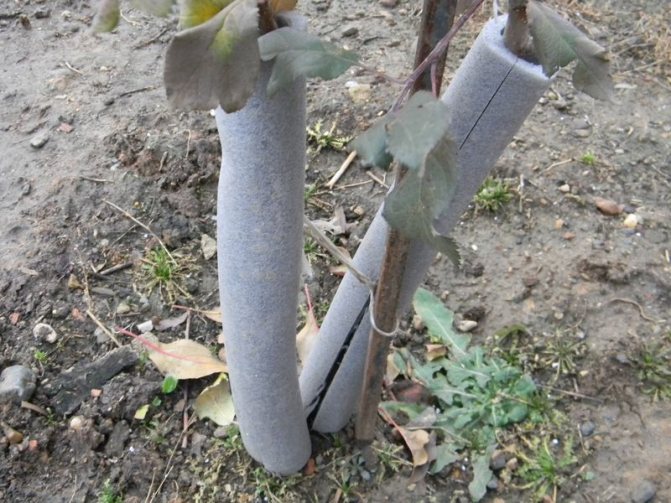

To insulate trees, special covering materials are needed, for example, spunbond. The main condition is that the material must be breathable. Therefore, expensive products sold in agricultural shops are often replaced by gardeners with improvised means.
What materials are suitable for creating winter shelters:
- newsprint or toilet paper;
- spruce branches;
- sackcloth;
- reeds;
- rags.
It is better not to use straw - rodents will definitely try to get into it, and wire for tying - it can injure the bark of trees. Reeds should also be used with caution - they may interest mice.
Attention!
To insulate trees, it is not recommended to use plastic wrap and bags - they do not allow air to pass through, so the tree does not develop under them and can resist.
Also, during covering work, you will need a rodent net - plastic or metal. It is recommended to poison rats and mice in advance by spreading the poison in their holes.
Protecting apple trees from rodents
For this, the plants are whitened. It is imperative to carry out this procedure in the case of young trees (four to five years old), the bark of which has not yet hardened. Freshly planted apple trees are whitewashed with chalk solution. Older trees can be whitewashed with lime mortar if necessary. You need to prepare it as follows: add two kilograms of clay and twenty liters of water to six kilograms of freshly slaked lime. In addition, two hundred grams of preheated wood glue and a kilogram of copper sulfate can be added to the solution.
Pests and diseases of apple trees
The most important stage in caring for any plant is its treatment, as well as the prevention of possible diseases. The most common pests: Eastern moth, green apple aphid, hawthorn. The first one looks like a brown-red caterpillar, about 1.3 cm in size. Its butterfly has a wingspan of 1.5 cm. The front wings are brown with gray, and the back ones are solid gray. The apple aphid is a small insect about three millimeters in size.
Hawthorn caterpillars are approximately five centimeters long and are dark in color with orange and black longitudinal stripes. Their butterflies are also quite large. Their wingspan is about seven centimeters. The veins on the light winglets are clearly visible. All of these insects can be fought with various insecticides. Spraying is also carried out for prophylaxis.
Tips from seasoned gardeners
At first, it is quite difficult for a beginner to get a good harvest, since only an experienced gardener knows the tricks of growing an apple orchard. If you apply all the advice and recommendations of experts in their field, then you can achieve an excellent result. Here are the secrets of getting a high yield of apples.
Correctly formed crown
The branches must be guided horizontally along their entire length. For this, weights are used or tying branches to pegs stuck in the ground. A young seedling is formed using the clothespins method. A clothespin is attached to a still green branch in such a way that its bifurcated end rests against the base of the shoot.
Pruning branches
By shortening a branch by a third of its total length, you can double the yield of the crop. It is also necessary to thin out the crown by completely removing defective, growing vertically or inside the crown, weak and diseased branches. Places of cuts must be processed with garden varnish.


Apple tree pruning
Control over the number of fruits
The central fruit should be removed from each bunch on a young tree. They usually have flaws and take away the strength of the apple tree. It is necessary to rid her of all the sick, deformed specimens. You can shake the tree so that some of the defective fruit crumbles itself.
Important! In order for apples to enlarge, it is necessary to observe the ratio: there are about 40 leaves per 1 fruit.
Chemical method of thinning
For tall apple trees at the flowering stage, chemical preparations can be used:
- 100-300 g of soda ash (1-3%) per 10 liters of water;
- 50-150 g of chloramine (0.5-1.5%) per 10 liters of water.
Spraying flowers with these preparations can halve the number of ovaries. This gives the fruit enlargement, an improvement in their taste properties and a high yield for the next year.
Wells for feeding
Holes must be drilled in order for nutrients from water and top dressing to penetrate to the roots faster. It is enough to make one hole for each square meter of the stamping circle, in the zone of the active root system of the plant. The depth of the well is up to 60 cm, the diameter is 10-12 cm. The cavity of the wells is filled with drainage material, for example, sand or crushed stone. It is in them that nutrient solutions and water are poured.
In addition to the listed recommendations, the condition for proper watering, feeding and protecting the apple tree from pests remains unchanged. With this care, an outstanding harvest will be a realistic goal for any gardener.
What if the apple tree bent over?
In the case when, under the influence of strong winds, the apple tree bends in one direction, many people think that it is no longer possible to fix it. But this is not true. What to do to make the tree even again? You need to drive a stake into the ground from the side opposite to the one into which the apple tree bent, gently pull the tree up to it and tie it. You can also put a support on the side into which the apple tree arches. Of course, in one day the tree will not become even; this requires at least three years, after which it will already be possible to remove the support.
Insulation of the trunk and roots
Frost preparation will be incomplete without insulation of roots and tree trunk... This will require:
- Loosening the soil;
- Covering with peat, manure or sawdust to save the root system from freezing;
- Preparing young apple trees for winter requires additional raking of a tubercle 35-40 cm high;
- The snow cover can be considered additional insulation, creating a slide around the trunk.
Annual seedlings do not have the time to grow stronger to frost and suffer from frost. Gardeners need to take a little time and insulate them by wrapping them around the trunk with material and fixing them with tape.


Warming of the seedling by means of additional raking of the tubercle.
The material is:
- Multiple layers of paper;
- Spunbond;
- Roofing material;
- Cloth or burlap.
If the above materials are not at hand, then you can use spruce or reed.
ATTENTION! Seedlings for winter is a must tie up... To do this, a stake is driven into the ground and a tree is tied to it. Thanks to this, the tree will not die from the winds.

